Affiliate disclosure: This post may contain affiliate links. Please see our Privacy Policy.
Rose petal wine captures the delicate floral aroma of fresh rose petals in a wine that’s light and fresh, perfect for summertime sipping. Rose mead, on the other hand, is deep and complex. It’ll bring you back to warm summer days even as winter rages outside.
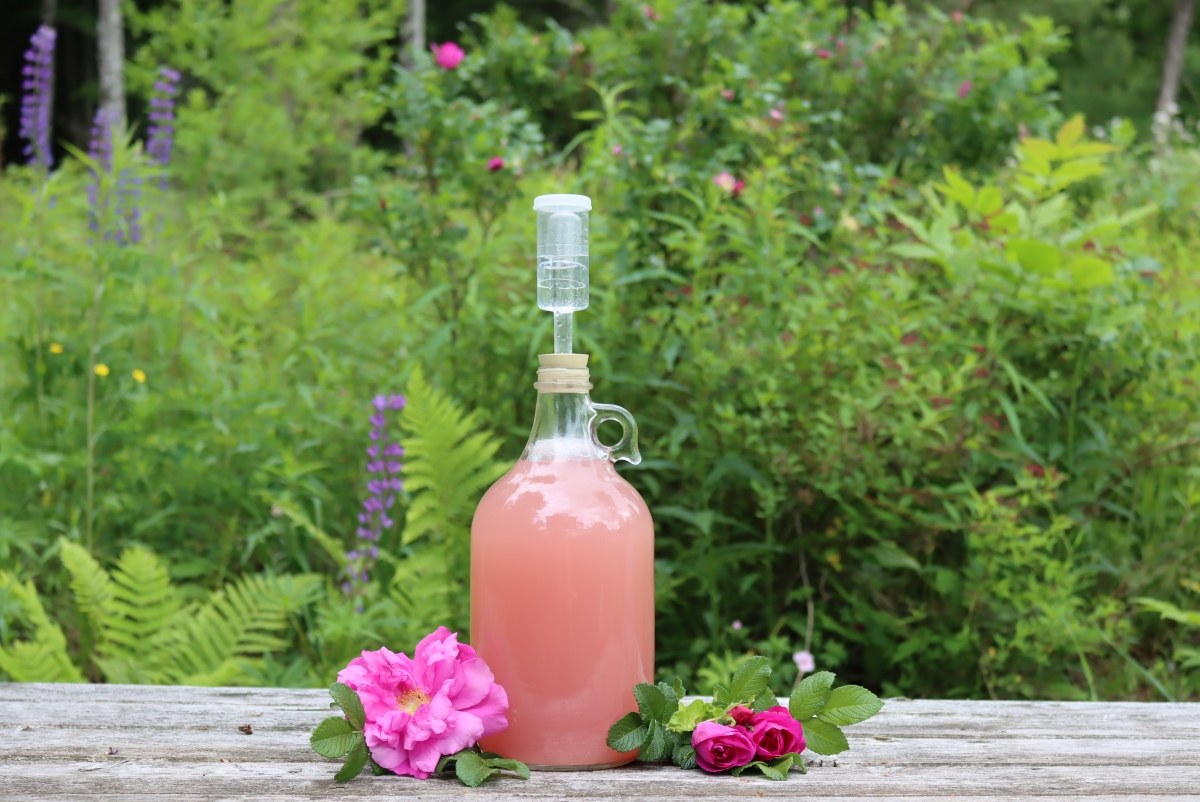
The scent of fresh roses fills our yard each June, and every year I promise myself I’ll use them for something magical. We’ll make the occasional batch of rose cordial, and the kids absolutely love the non-alcoholic version that makes decadent rose soda with a bit of seltzer.
I’ve even made rose jelly a time or two to add to our ever-growing selection of floral jellies.
While those are good, I’ve been hoping for something a bit more mature and something that can bring me back to these sun-filled days once our long Vermont winter takes hold.
Both rose wine and rose mead (honey wine) will be maturing in the cellar for a few months, but they’ll be ready right when I need them!
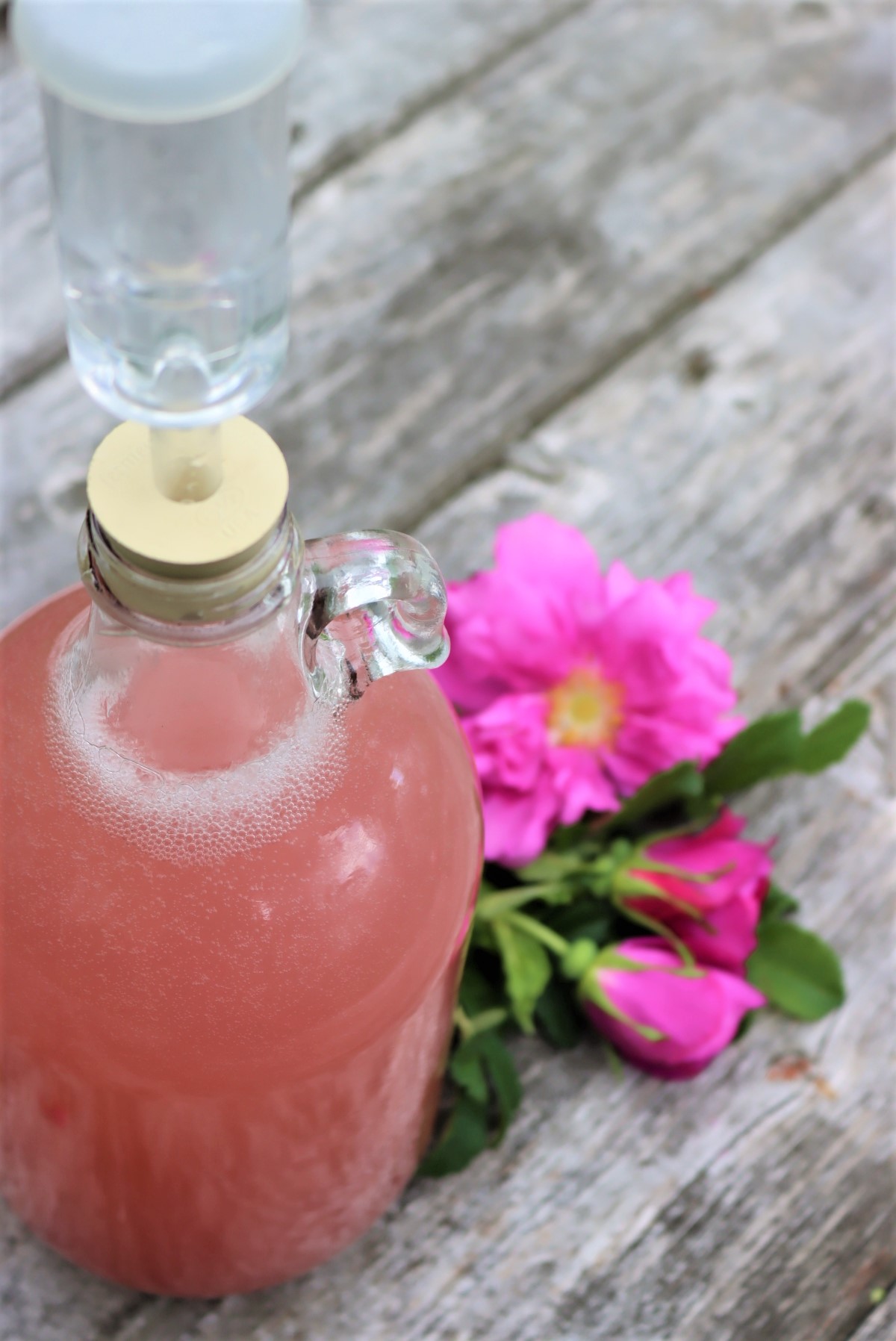
Rose Wine or Rose Mead (Rhodomel)
Though I have literally dozens of wine recipes posted, my absolute favorites are honey mead rather than regular fruit wines.
Meads take a bit longer to mature, but they have an incredibly complex flavor and full body that’s just to my taste. Its rich body is perfect for winter sipping, whereas wines tend to be light and are better chilled for summertime sipping.
Honey wine also costs considerably more to make since honey, especially good-quality honey, is expensive.
This year I made both, and you can really see the difference in color (below). The rose wine is made with white sugar, which allows the drink to maintain a bright pink color. Rose mead, on the other hand, is made with honey which turns it a darker color.
I’ll share the recipe (and process) for both, and you can decide which suits you best.

How to Make Rose Wine
The steps involved in making rose wine are no different from any other country wine, and it’s quite similar to other floral wine recipes I’ve written, including dandelion wine and lilac wine. The main difference is in the flower petals, of course, but also in the choice of adjunct flavorings.
With dandelion wine, I add the sunny citrus flavor from the juice of a few oranges to bring out the natural bright notes in dandelion petals. For lilac wine, I opt for more neutral lemon juice as a source of acidity to help the yeast thrive and then add a few blueberries to bring out the berry notes in fragrant purple lilac flowers.
For rose wine, I’m again going to stick with lemon juice for acidity, but I’m also adding in just a hint of warm spice with the addition of cardamom.
The other difference is that this time I’m making rose wine with the addition of white grape juice for part of the liquid (instead of all water). White grape juice has a very mild taste, and won’t contribute much to the finished wine flavor-wise. It will, however, add body and mouthfeel that can be lacking in floral wines made without any fruit at all.
I’m using it in the rose wine but not the rose mead, as the honey in mead provides excellent body to the finished beverage.
If you’re not familiar with winemaking, I’d suggest reading through this beginner’s guide to small-batch wines which discusses the steps and equipment for making anywhere from 1 quart to 1 gallon of wine at a time. For mead, start with this tutorial on how to make mead (honey wine).
This recipe is standardized to a one-gallon batch of either rose wine or rose mead, but it can be reduced or increased as necessary. Simply multiply or divide all the ingredients as appropriate, with the exception of the yeast.
A packet of yeast is good for 1 to 5 gallons, so use a whole pack for those amounts. Just sprinkle in part of a pouch for batch sizes under a gallon.
Any wine yeast will do, but I’d suggest Red Star Premier Côte des Blancs, which is known to contribute fine, fruity aromatics to a finished wine. It also has a low alcohol tolerance (around 13%), so the finished wine will have some residual sweetness. If you choose generic champagne wine yeast, which is a vigorous fermenter and good for just about anything, it’ll finish at around 18% alcohol resulting in a much dryer wine without as much fruity aroma.
To make this wine, you’ll need:
- Rose Petals, Fresh Picked or Food Grade Dried Rose Petals
- White Sugar for Wine or Honey for Mead
- White Grape Juice ~ Just for the wine, to add body to the finished wine. It’s omitted in the mead, as honey adds great body on it’s own.
- Yeast Nutrient ~ The little beasties cannot live on sugar alone, and there are no grapes in this recipe to provide the other nutrients.
- Wine Tannin ~ This helps give the wine body and balances out the mouthfeel so they’re well-rounded. You can also use a cup of strongly brewed black tea to added tannin.
- Acid Blend ~ This adjusts the pH so the yeast can thrive. Use 3 tsp acid blend per gallon, or substitute 3 tablespoons lemon juice.
- Wine Yeast ~ Don’t use bread yeast, it makes wine taste horrible and you’ll regret it. Any wine yeast will do, but as I said, I suggest Red Star Premier Côte des Blancs.
- Narrow Neck Carboy (Demijohns) with Water Lock ~ This is your fermentation vessel. Preferably you’d have two so you can move it into a clean one after the primary.
- Siphon ~ This is used to carefully remove the wine from the fermentation vessel without disturbing the sediment (known as racking). It’s also used at bottling time.
- Bottles ~ For short-term aging under a few months, you can use flip-top Grolsch bottles. For longer-term aging suggested for mead, use wine bottles, corks, and a wine corker.
This recipe for Rose Wine is Adapted from the Book Home Winemaking by Jack Keller. He uses sulfites in his wines, which I avoid. If you use sulfites in your winemaking, you can refer to his instructions on page 284.
Selecting Rose Petals for Rose Wine
It all starts with fresh rose petals, or dried rosebuds will work as well. Color is much less important than the fragrance, and you want to select the most fragrant blossoms possible. Of course, red and pink blossoms will give a lovely color to the finished wine as a bonus.
Be sure to choose unsprayed roses! Roses in most gardens tend to be a high spray crop, and since they’re not generally eaten (though roses are edible), they are often sprayed with pretty noxious chemicals. Much worse than what’s allowed for food crops, so they can make you quite sick.
Our roses are an especially fragrant wild type of rose that grows without care or spray just about everywhere here in Vermont, and we never spray them. They take root just about anywhere the animals drop discarded seeds after they’ve feasted on the sweet rose hips and thrive all on their own.
I find they’re most fragrant just after the bees have visited each flower mid-day, so I harvest them in the late afternoon and early evening. I only pull the petals, leaving the base of the rose. That means we’ll still get to harvest rose hips later on in the season.
You’ll need about a quart of rose petals, lightly packed for a one-gallon batch of rose wine. By weight, that’s about 3 ounces of fresh petals. (More is fine too!)
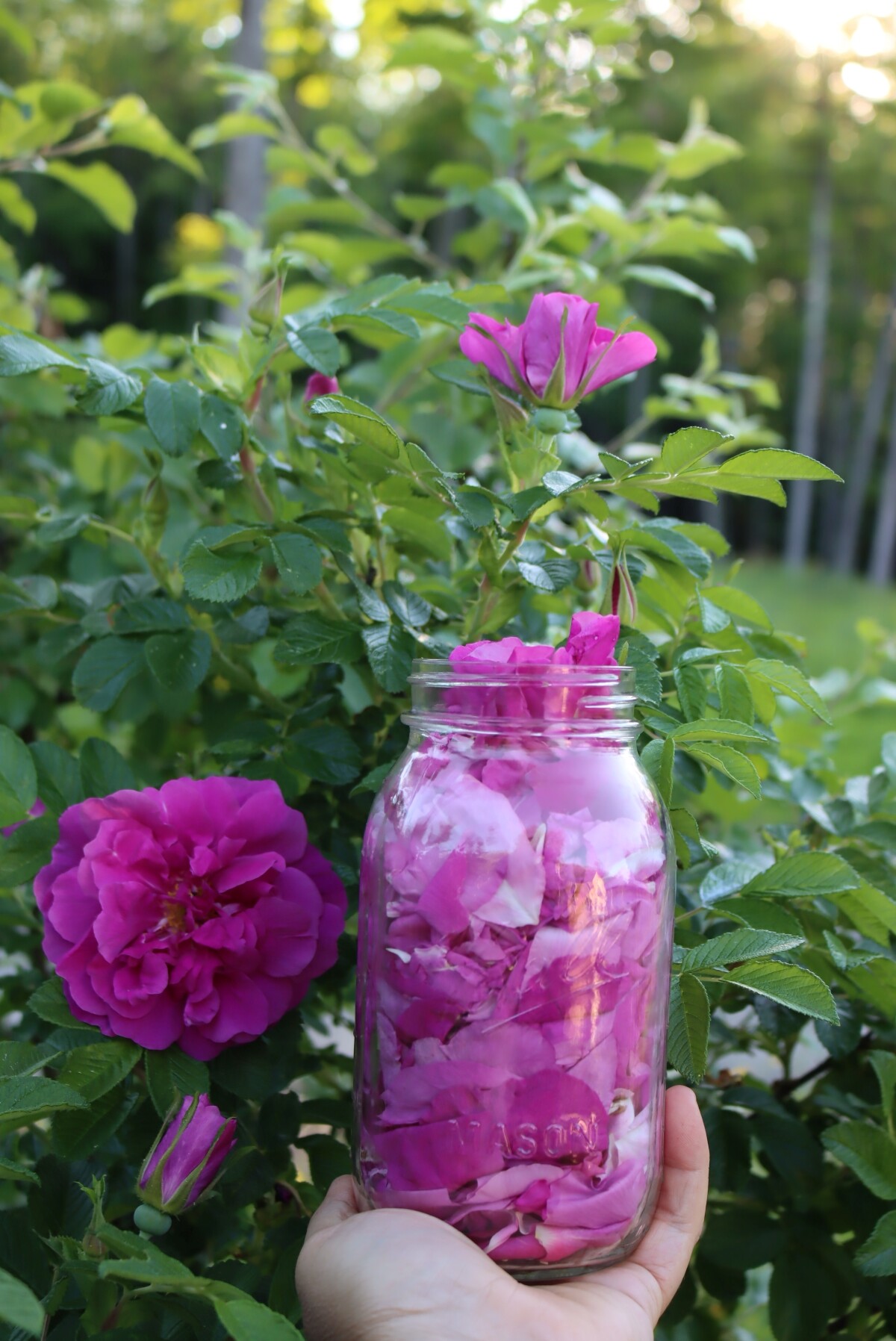
You can also make rose wine with dried rosebuds, purchased from a supplier that sells food-grade blossoms. Mountain Rose Herbs is a good source, as is Starwest Botanicals. Both have fragrant, unsprayed food-grade rose blossoms that are perfect for all manner of tasty recipes (or body products too).
If using dried rosebuds, opt for a bit less weight since they’ve had the water removed. Go with 1 1/2 to 2 ounces, or about 50 grams of rose petals.
Fresh or dried, the process is the same. Place them in about 1/2 gallon of water on the stove and bring the pot to a gentle simmer (covered). Once simmering, turn off the heat and allow the petals to infuse for 15 to 20 minutes.
The color will be unimpressive until you add in a bit of lemon juice, which will brighten the pot to something close to the finished color you can expect from your rose wine.

While the water is still hot, strain the rose petals and add in sugar (or honey for mead). Stir to completely dissolve.
At this point, add in the other winemaking ingredients (except yeast).
Pour the mixture into a carboy, and top with cool water. Ideally, the cool water brings the mixture down to below 95 degrees so that you can add the yeast at this point. If not, wait patiently until it cools before adding the yeast.
Adding the yeast when the mixture is above 95 degrees (or about blood warm) will kill the yeast, and your rose wine just won’t work.
It’s best to dissolve the yeast in 1/4 to 1/2 cup of room temperature water and allow it to “bloom” for 10 minutes before putting it into the sugar water. Going straight from the refrigerator into a sugar-y liquid can shock the yeast, and they do better when woken up gently in plain water so they can rehydrate fully before going to work.
Pour the yeast/water mixture into the carboy, and fill further if necessary with water to bring the fill line to the neck of the jug. Cap with a water lock and allow the mixture to ferment for 2 to 3 weeks.
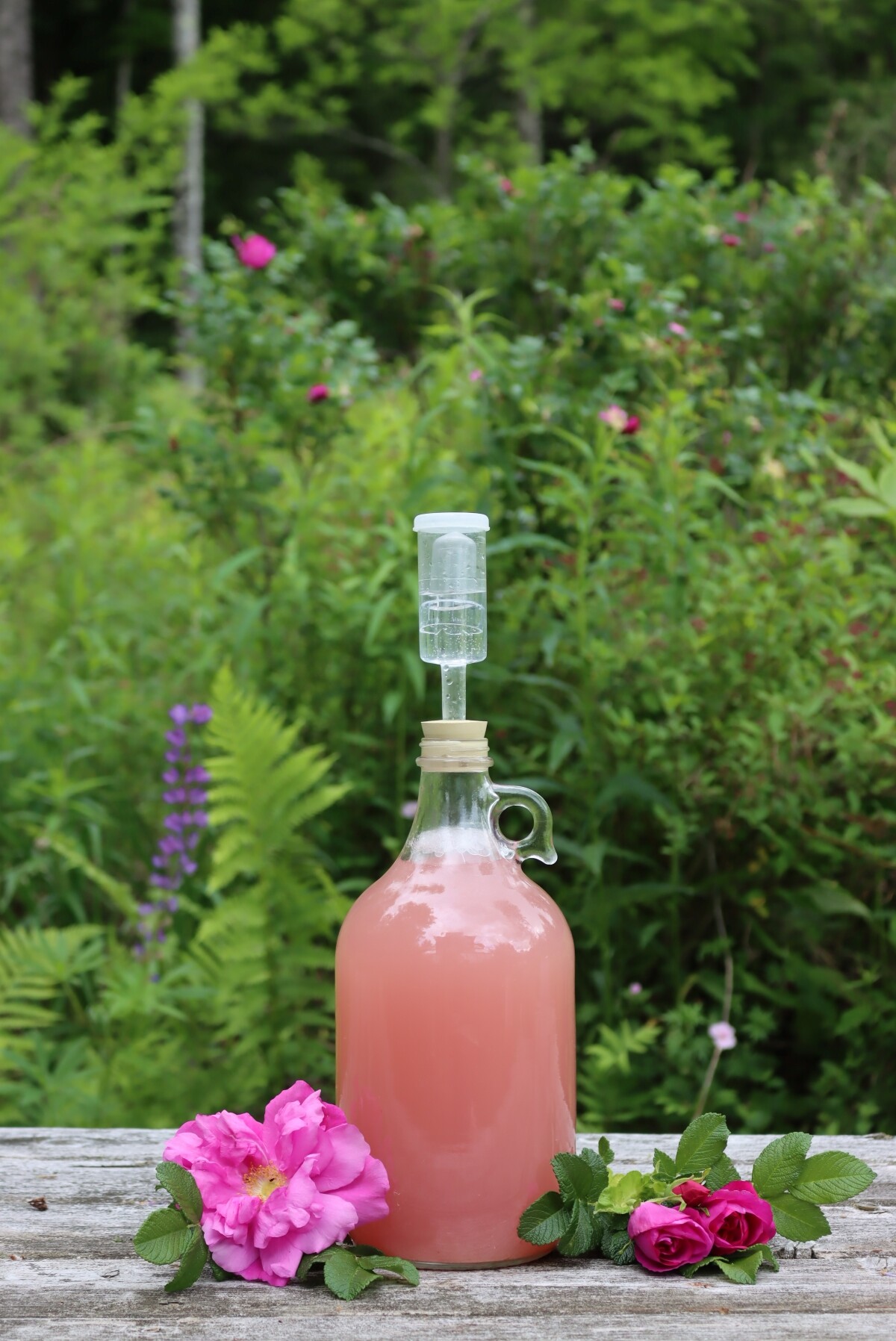
After the initial 2 to 3 weeks of fermentation, known as primary fermentation, things should have slowed down a bit. There should be a good bit of yeast sediment at the bottom of the jug, and the water lock should be releasing gasses much less frequently.
At this point, the wine’s not finished but it does need to be moved to a new clean container. Leaving the wine on top of the “lees” or dead yeast at the bottom can result in off-flavors, and rose wine has a pretty delicate flavor.
Use a siphon to transfer the wine to a new clean carboy (known as racking), and re-cap with the water lock. If necessary, fill the container with water, white grape juice, or better yet, more cooled rose blossom tea to bring the level back up to the neck of the jug.
For rose wine, allow the mixture to ferment with the water lock on for another 6 to 8 weeks before bottling.
For rose mead, yeast digest honey at a much slower rate and will need more time. A lot more time. Allow the mead to mature in secondary for at least 4 months, preferably 6 to 8, before bottling.
Bottle in flip-top Grolsch bottles for short-term storage, or corked wine bottles for storage longer than a few months. Either way, allow the wine to bottle-condition for at least 2 weeks before drinking. For mead, I’d suggest at least 2 months.
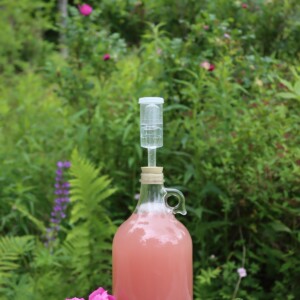
Rose Petal Wine (and Mead)
Ingredients
Rose Petal Wine
- 3 ounces Fresh Rose Petals
- Or about 2 ounces dried
- 2 1/2 lbs Sugar, about 5 cups
- 6 cups white grape juice, or 1 can concentrate and water
- 1 tsp yeast nutrient
- 2 tsp acid blend, or 2 Tbsp lemon juice
- 1/8 tsp tannin powder, or 1 cup strongly brewed black tea
- 4-5 cardamom pods, optional
- 1 wine yeast, Premier Côte des Blancs reccomended
Rose Petal Mead
- 3 ounces Fresh Rose Petals
- Or about 2 ounces dried
- 3 lbs honey
- 1 tsp yeast nutrient
- 2 tsp acid blend, or 2 Tbsp lemon juice
- 1/8 tsp tannin powder, or 1 cup strongly brewed black tea
- 4-5 cardamom pods, optional
- 1 wine yeast, Premier Côte des Blancs reccomended
Instructions
- Decide whether you're making rose petal wine or mead. The ingredients for both are listed above and are slightly different. Wine has added white grape juice which gives the wine body, where as mead skips that since the honey provides nice body to the wine. Instructions are the same either way, with mead taking slightly longer to finish.
- Add about half a gallon of water and the rose petals (and cardamom pods if using) to a saucepan and bring to a simmer on the stove, coved. Once simmering, remove from heat and allow the petals to infuse for 15 to 20 minutes.
- Strain the petals and add the sugar or honey while the water is still hot. Stir to dissolve.
- Add the remaining winemaking ingredients (except yeast), and stir to incorporate.
- Pour into brewing vessel (demijohns) and add cool water to nearly fill the container. Mead will require more water since there's no grape juice.
- Allow the mixture to cool to no hotter than 95 degrees F, but ideally to around room temperature.
- Once cool, dissolve the yeast packet in about 1/4 to 1/2 cup room temperature water and allow it to rehydrate for 10 minutes. Add the yeast water to the fermentation vessel.
- Fill with water (if necessary) to reach the neck of the fermentation vessel, and seal with a rubber stopper and water lock.
- Allow the wine to ferment for 2-3 weeks until fermentation slows (primary fermentation).
- Use a sciphon to transfer the wine to a clean fermentation vessel, taking care to leave any sediment behind. Re-cap with a water lock. For wine, allow it to ferment in secondary for about 6 weeks. For mead, a minimum of 4 months.
- Bottle the wine or mead. Allow wine to bottle condition for at least 2 weeks, and wait at least 2 months for mead. Flip top grolsch bottles will work for short term storage, but wine bottles are better if stored for more than 2-3 months.
Winemaking Recipes
Interested in home winemaking? Read on my friends!
Mead Recipes
Honey wines more your thing?
Fermented Beverages
Believe it or not, wine and mead are just the beginning!
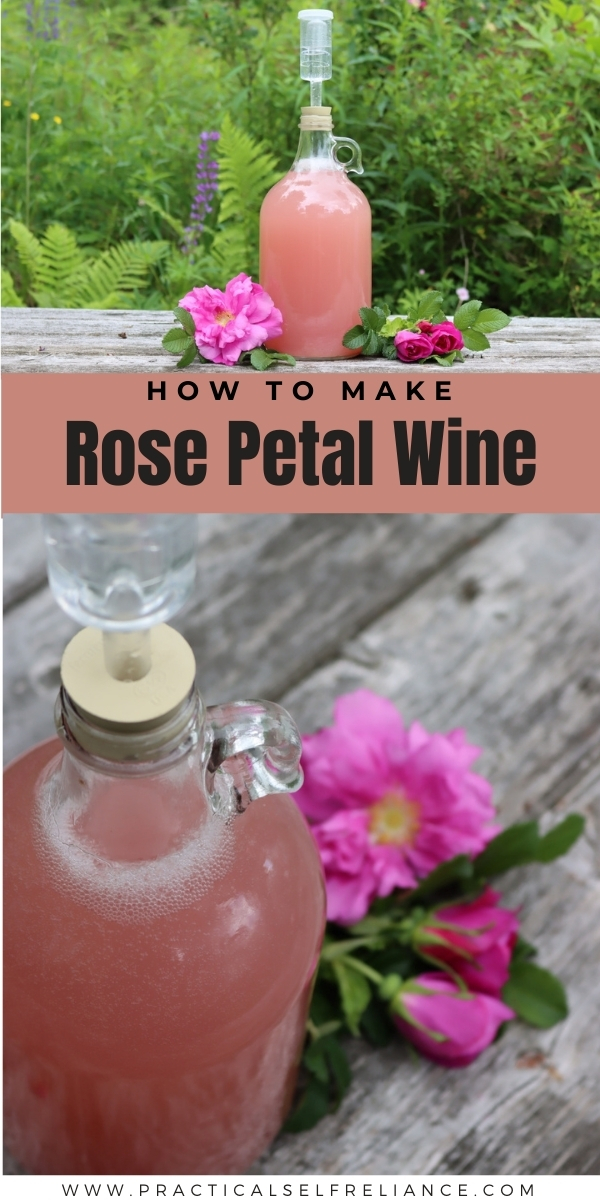



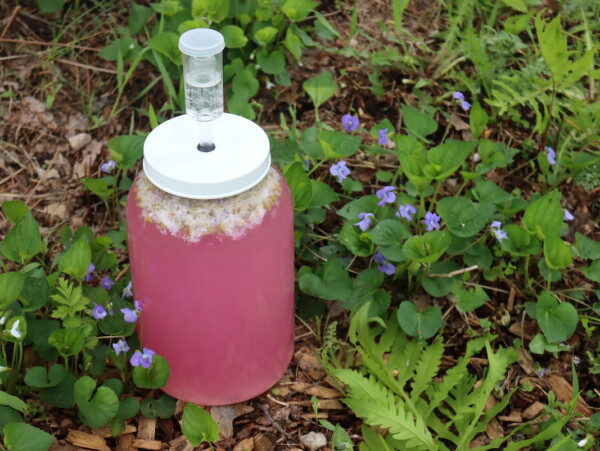
Hello! I was wondering if I could use dried flowers in all the the wine making recipes?
You sure can.
Hi, first time making mead, on step 3 it mentions (except yeast), this may be a dumb question but which yeast should I hold off? Yeast nutrient or the wine yeast? Thank you
Love, Ness
That’s talking about the yeast itself. You don’t want to add it while the mixture is too hot. The rest of the ingredients need to dissolve in warm liquid, but the actual living yeast needs to wait until the mixture is room temperature.
Just a little question. My rose infusion came out bitter. Is this normal? (Maybe because of the long steeping time or because of the heat) Or should I restart? I collected the rose petals a day in advance, therefore they weren’t as fresh and already had some brown spots. Just trying to figure out wether to toss this Infusion and make a knew one or to proceed
It shouldn’t be bitter. How long did you steep them for?
Rose petal mead! Oh my. this sounds amazingly luxurious! I would love to try this. What fun! Great blog.
Howdy, My name is Will and I’ve been brewing meads and mellomels for a little more than 50 years. I thought you might like to hear how I brew meads etc. I have been told by many that my mead is excellent. I brew in 5 gallon batches and lately I have ageing 1 1/2 gallons in an oak keg for a few months. First, all you need is between 15 lbs of honey for dry mead and 18 lbs for sweet mead. I sometimes make an infusion of hibiscus, rose, or similar edible flower petals, about 1/2 lb of dried petals in 1 gallon of hot water. For the first 30 or so years I used your basic bread yeast and it worked just fine, about a teaspoon for 5 gallons, along with a handful of raisins and I cover the carboy opening with 3-4 layers of plastic wrap held tight with a rubber band, but the yeast you suggested is great too as is champagne yeast. You don’t need a bubbler to know when the brew is done: the raisins stop swimming around and settle at the top, after about 2-3 months. Hope you find this interesting.
Thanks for sharing.
I am making a micro batch of the rose mead. Do I still need to do the same ferment times? They’re quite a bit longer than the Linden Mead micro batch recipe, so I’m wondering if I should adjust accordingly. Thanks :).
The size of the batch shouldn’t affect the fermentation time but the ingredients will. I would just follow the directions as written for the rose mead.
Thank you! Just saw your comment now as I’m going to make a second batch.
You’re welcome. Let us know how it turns out for you.